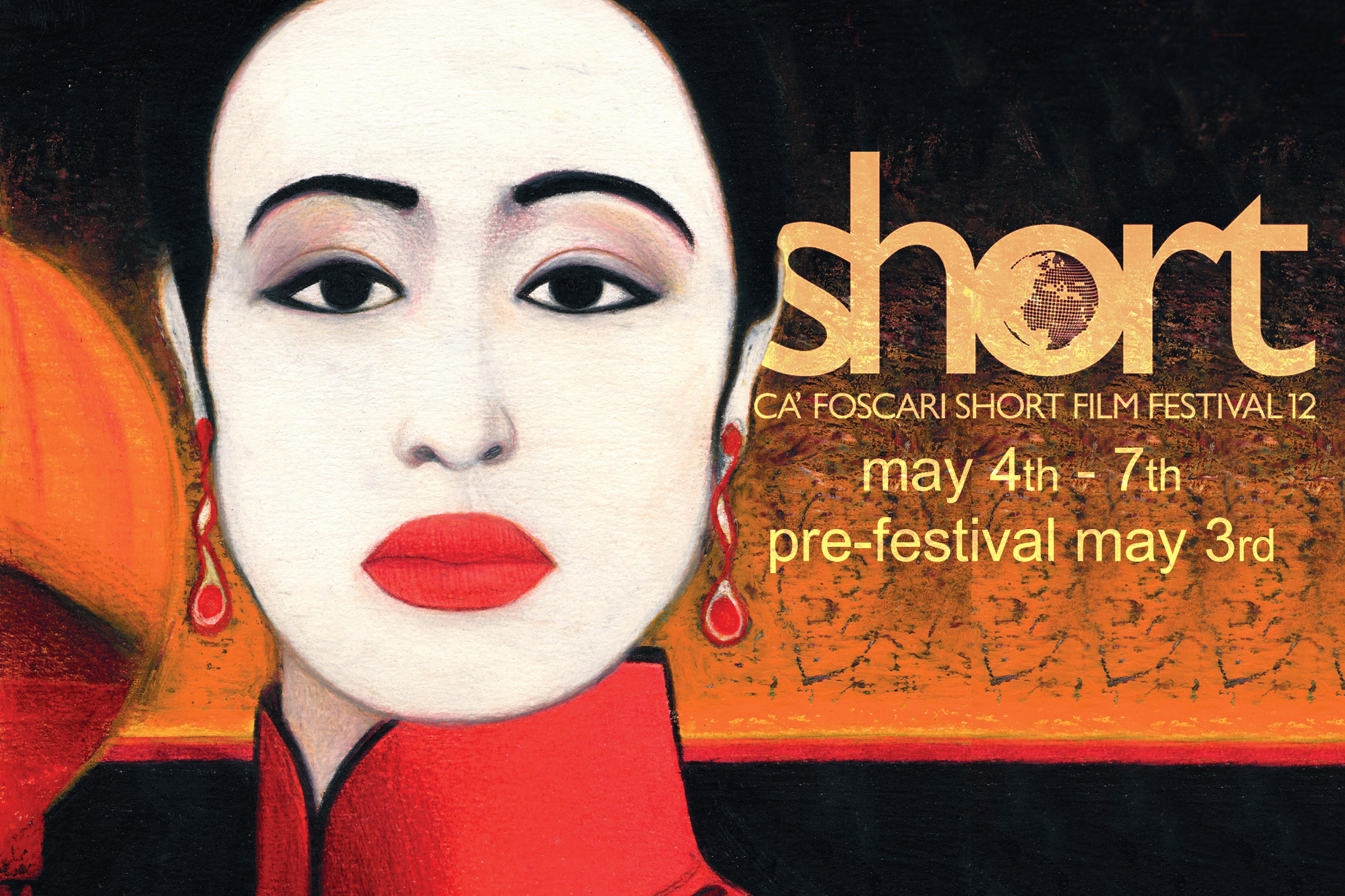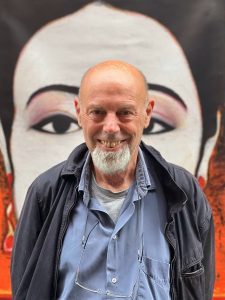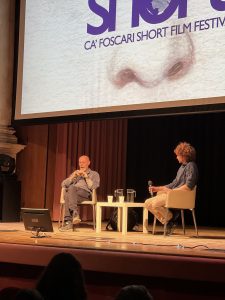
 Before the closing ceremony, the program of the twelfth edition of the Ca’ Foscari Short Film Festival ended with a special masterclass by one of the most awaited guests: Luca Bigazzi, director of photography of some of the most important Italian films of the last thirty years. His career was retraced in a lectio magistralis, in which he illustrated his work method, also talking about some clips from Ariaferma, one of his latest works, which has already won two David di Donatello awards. Introducing him on stage and leading the interview was Robin Andrioli, former student of the Master in Fine Arts in Filmmaking at Ca’ Foscari, now director of photography himself.
Before the closing ceremony, the program of the twelfth edition of the Ca’ Foscari Short Film Festival ended with a special masterclass by one of the most awaited guests: Luca Bigazzi, director of photography of some of the most important Italian films of the last thirty years. His career was retraced in a lectio magistralis, in which he illustrated his work method, also talking about some clips from Ariaferma, one of his latest works, which has already won two David di Donatello awards. Introducing him on stage and leading the interview was Robin Andrioli, former student of the Master in Fine Arts in Filmmaking at Ca’ Foscari, now director of photography himself.
Seven David di Donatello, seven Nastri d’Argento and curator of photography of the Oscar-winning film La grande bellezza: Luca Bigazzi is the most important director of photography of contemporary Italian cinema. He made his debut as DoP in 1983 with Paesaggio con figure by Silvio Soldini and his artistic collaboration with the director led him to win two David di Donatello awards: in 2000 with Pane e tulipani and in 2002 with Brucio nel vento. His career boasts famous collaborations, including those with Mario Martone, Giuseppe Piccioni, Ciprì and Maresco, Paolo Virzì and Daniele Luchetti. In 2004 he began collaborating with Paolo Sorrentino, with whom he obtained a series of prestigious awards, winning for example both the David di Donatello and the Nastro d’Argento as best director of photography for Le conseguenze dell’amore in 2005, for This Must Be the Place in 2012 and for The Great Beauty in 2013.
The meeting at the Auditorium was an opportunity to retrace Bigazzi’s long and award-winning career, since his debut with Paesaggio con figure, a film he made in high school with his classmate Silvio Soldini: “We shot it in six months, I knew absolutely nothing, I had never attended a film school or read a photography book”. However, he confesses, this initial inexperience has turned into one of his greatest strengths over the years, because, paradoxically, experience can turn out to be an obstacle: “I believe that preparing too much is a mistake. My main quality is that I forget everything so I never apply the same method, it’s as if for each film I do everything all over again. Experience is a terrible detriment, you risk repeating what you have already done”. Bigazzi therefore invited young directors and aspiring DoPs to claim and defend their youth, which can bring creativity and innovation.
 Another peculiar characteristic of the “Bigazzi method” is definetly speed, which is the main quality of a cinematographer according to him. “My obsession is to be fast: the slower I am, pretending to be artistic, the more I damage the film,” he confessed to the public, emphasizing how speed is essential even in relation to light, which varies continuously during the day, altering the shots. The light, in fact, occupies a large part of DoP’s work; however, Bigazzi is known to use very few lights and on the stage of the Auditorium he revealed the reason for this choice, starting with the screening of a scene from Ariaferma, a film he worked on last year with director Leonardo Di Costanzo. The chosen clip featured a scene shot in a prison where the power suddenly goes out: Bigazzi told how he didn’t add any lights, letting the actors become ‘chief electricians’ by lighting the scene with simple flashlights. “Ten years ago such a scene, with fifteen minutes of darkness, would have been impossible. I would have had to use a lot of off-screen lights, penalizing the logic of the story to follow the aesthetics. I probably would have directly rejected the film.” The scene in question, like many others, was made possible thanks to the use of new digital techniques, thanks to which, according to Bigazzi, the work is considerably simplified.
Another peculiar characteristic of the “Bigazzi method” is definetly speed, which is the main quality of a cinematographer according to him. “My obsession is to be fast: the slower I am, pretending to be artistic, the more I damage the film,” he confessed to the public, emphasizing how speed is essential even in relation to light, which varies continuously during the day, altering the shots. The light, in fact, occupies a large part of DoP’s work; however, Bigazzi is known to use very few lights and on the stage of the Auditorium he revealed the reason for this choice, starting with the screening of a scene from Ariaferma, a film he worked on last year with director Leonardo Di Costanzo. The chosen clip featured a scene shot in a prison where the power suddenly goes out: Bigazzi told how he didn’t add any lights, letting the actors become ‘chief electricians’ by lighting the scene with simple flashlights. “Ten years ago such a scene, with fifteen minutes of darkness, would have been impossible. I would have had to use a lot of off-screen lights, penalizing the logic of the story to follow the aesthetics. I probably would have directly rejected the film.” The scene in question, like many others, was made possible thanks to the use of new digital techniques, thanks to which, according to Bigazzi, the work is considerably simplified.
For years now, the director of photography has declared that he much prefers movies shot digitally to those that use films, for the realism that comes with it, for its ease of use, but above all for the quality of the final product. “I have suffered monstrously all my life making unrealistic things because there were not the right tools. Now you young people have in front of you instruments of reproduction of reality that I could only dream of when I started; just use them without having the regret of the past.” Bigazzi then concluded by taking about the opportunity to give advice to the new generations: “Conservatism and resistance to innovation are very harmful. Trust your instinct, use the means available and experiment as much as possible: do not throw away your youth, it is the most precious thing you have”.

